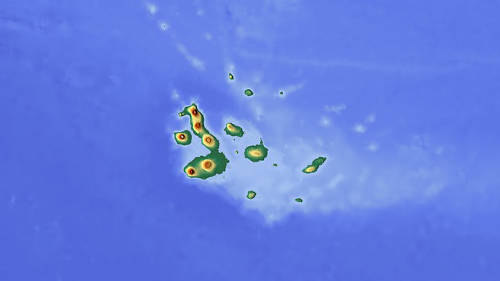Galápagos
General
The Galápagos Islands are an archipelago of 18 main islands, three smaller islands and 100 or so rocks and islets. They are situated about 900 kms west of Ecuador, to which they belong, and straddle both sides of the Equator. Their local name is the Archipiélago de Colon.
The islands are world famous because of their unique wildlife, and because of Charles Darwin's voyage here, when he formulated the theory of evolution.
The islands, and the seas around them, form the Galápagos Province of Ecuador, the Galápagos National Park, and the Galápagos Marine Reserve. Because they are so unique, they are strongly protected. You need to buy an entrance ticket to get onto the islands.
The population is about 25,000, and the main language is Spanish. The islands are volcanic, and 13 of the volcanoes considered to be still active. The most recent eruption was Wolf volcano on Isabel Island, in 2015.
The climate You'd think it would be hot all the time, as the islands sit across the Equator, but the Humboldt current brings cold water, and El Niño variability. It's usually warm - check the charts below. Sometimes you may need a wetsuit - these are usually provided.
Currency: (Since 2000). The US dollar is the official currency of Ecuador. Only coins continue in the local currency (centavos).
Flights There are no direct flights to the islands: you need to fly to Ecuador's capital, Quito, or its biggest city, Guayaquil, and transfer from there. Flights to Quito or Guayaquil are about 12 hours. Flights to the islands then take about 2 hours. If you're thinking of staying over in Quito, you should remember it's the second highest capital city in the world - almost 3,000 metres above sea level. People who get altitude sickness should consider flying from Guayaquil, which is at sea level.
Time in Galápagos: UTC - 6.00
Entry requirements: For Ecuador: passport valid for six months, return ticket. For the islands: you will have your baggage inspected for biosecurity by quarantine staff in Ecuador: pay a $20 for a tourist transit card: and pay $100 in cash when you get to the islands, as an entrance fee. And you have to have a return ticket.
Visas? Not for visits of less than 90 days. See the Galapagos Conservancy website: https://www.galapagos.org
(written February 2018)



Climate charts for Galápagos Islands
The first things you should do when you look at these temperature charts is get rid of your preconceptions: "a lot of rain in March, so it will be cold, not a good time to go".
Actually, the reverse is true. June through December are considered the cooler months - when the sea birds and animals get more active. January through May is the warm season, when the sea warms up and snorkelling is a delight. April to October is the low season, when you can get cheaper deals. All the guides are unanimous that you can travel here any time of the year and see extraordinary wildlife. You just need to research what each month has to offer.
You should also doublecheck the climate charts: we saw a good deal of variation when we were researching the charts above. You could check rowadventures.com or galapagosisland.net - both commercial sites, but they have good information.
The UK Foreign Office warns against travel in the 20kms close to the Colombian border, and has warnings against particular regions in Ecuador. It also points out the risk of seismic activity in the country, and of muggings and pickpockets in parts of Quito and Guayaquil. You should check the website. https://www.gov.uk/foreign-travel-advice/ecuador. They also say there is a risk of Zika virus in Ecuador.
Galapagos Islands
We would welcome a report on snorkelling in the Galapagos. if you have experience of this magical place, please do get in touch.
Useful links:
Would we go again?

Usual warning: we have made very effort to make sure this information is correct and up-to-date, but you need to check it all yourself.
© Garreg Lwyd Ltd 2017
